What is Zooplankton?
- Zooplankton, derived from the Ancient Greek words “ζῷον” (zôion) meaning ‘animal’ and “πλαγκτός” (planktos) meaning ‘wanderer’ or ‘drifter’, represent a diverse group of heterotrophic organisms found in aquatic environments. These organisms, which range from microscopic entities to larger species like jellyfish, play a pivotal role in aquatic ecosystems, particularly in the food chain.
- Situated in vast water bodies, from oceans to freshwater systems, zooplankton are characterized by their inability to swim effectively against currents. This trait results in their drifting nature, being carried by the whims of oceanic, sea, lake, or river currents.
- This drifting community of organisms, known as plankton, is bifurcated into two primary components: zooplankton (animal-based) and phytoplankton (plant-based). The distinction is rooted in their nutritional processes.
- Phytoplankton, derived from the Ancient Greek “φῠτόν” (phutón) meaning ‘plant’, are autotrophic, capable of synthesizing their own food through photosynthesis. Zooplankton, in contrast, are heterotrophic, relying on external sources of organic substances for nutrition. This often involves consuming phytoplankton or other smaller entities.
- While the majority of zooplankton are microscopic, encompassing protozoans like foraminiferans, dinoflagellates, zooflagellates, and radiolarians, there exists a subset that is macroscopic.
- This larger group includes diverse organisms such as ctenophores, molluscs, tunicates, arthropods, and cnidarians. An interesting facet of the planktonic world is the phenomenon of mixotrophy.
- Some marine microplankton exhibit mixotrophic behavior, oscillating between autotrophic and heterotrophic nutritional modes. This blurs the conventional demarcation between plant and animal characteristics in these minuscule organisms.
- In summary, zooplankton are an integral component of aquatic ecosystems, serving as a bridge in the food chain between primary producers like phytoplankton and larger aquatic predators. Their presence and abundance are indicative of the health and vitality of their respective ecosystems.
What exactly are Zooplanktons?
Zooplankton, a subset of the broader planktonic community, are heterotrophic organisms that inhabit both freshwater and marine environments. The term “plankton” encompasses a diverse array of organisms that float or drift within aquatic realms. Among these, zooplankton are distinguished by their heterotrophic nature, signifying their reliance on external organic matter for sustenance, as opposed to autotrophic organisms that can synthesize their own food.
Specifically, zooplankton predominantly feed on phytoplankton, the autotrophic component of the planktonic community. This relationship underscores the pivotal role zooplankton play in aquatic food webs, bridging the gap between primary producers (phytoplankton) and larger aquatic predators.
The zooplankton community is diverse, encompassing a myriad of species ranging from the microscopic single-celled Radiolaria to the early developmental stages of larger organisms such as herrings, crabs, and lobsters. Within this vast assemblage, zooplankton can be further categorized based on their life cycle duration in the planktonic phase. Holoplankton, often referred to as permanent plankton, remain in the planktonic phase throughout their life cycle. Notable examples include copepods and protozoa, which serve as fundamental food sources for larger aquatic animals. In contrast, meroplankton, or temporary plankton, spend only a portion of their life cycle in the planktonic phase. These organisms, which include the larvae of starfish, clams, and worms, eventually settle in benthic or other habitats to mature into their adult forms.
In essence, zooplankton are a vital component of aquatic ecosystems, facilitating nutrient transfer across trophic levels and supporting the health and productivity of their habitats.
Characteristics of Zooplanktons
Zooplankton, a term originating from the Greek words “zoon” (meaning animals) and “planktos” (meaning wanderers or drifters), are heterotrophic organisms that inhabit aquatic environments. These entities exhibit several distinct characteristics:
- Nutritional Mode: Zooplankton are heterotrophic, implying that they obtain their energy and nutrients by consuming other organisms, including plants and animals.
- Diversity: The zooplankton community is diverse, encompassing a spectrum of organisms from protozoans to metazoans.
- Life Cycle Variability: Within the zooplankton community, there are two primary classifications based on their life cycle duration in the planktonic phase:
- Holoplankton: Organisms that remain in the planktonic phase throughout their entire life cycle.
- Meroplankton: Organisms that spend only a portion of their life in the planktonic phase, transitioning to benthic, nekton, or sessile stages in their life cycle.
- Locomotion: While primarily drifters, carried by the currents, zooplankton can exhibit limited locomotion. This movement aids in evading predators or enhancing encounters with prey.
- Distribution: Zooplankton are found throughout oceans in patchy distributions, influenced by factors such as salinity, temperature, breeding patterns, migration routes, and the concentration of phytoplankton.
- Ecological Role: Occupying a central position in the aquatic food web, zooplankton primarily feed on phytoplankton, bacterioplankton, other zooplankton, and even nektonic organisms. Their consumption patterns play a pivotal role in nutrient cycling within aquatic ecosystems.
- Biomagnification: Zooplankton can accumulate certain pollutants, such as mercury, leading to biomagnification as these toxins are passed up the food chain.
- Examples:
- Protozoan Zooplankton: This category includes dinoflagellates, zooflagellates, and radiolarians.
- Metazoan Zooplankton: Notable representatives are jellyfish, Portuguese Man o’ War, molluscs, amphipods, and crustaceans resembling shrimp.
- Disease Association: Some zooplankton, particularly crustacean varieties, can form symbiotic relationships with pathogens. For instance, certain crustacean zooplankton are known to associate with Vibrio cholerae, the causative agent of cholera.
In summary, zooplankton are integral components of aquatic ecosystems, influencing nutrient dynamics, food web structures, and even disease propagation. Their diverse nature and multifaceted roles underscore their importance in maintaining aquatic ecosystem health and balance.
Zooplankton Classification
Classification of Zooplankton Based on Size
Zooplankton, the heterotrophic organisms drifting in aquatic environments, can be classified based on their size. This size-based classification provides insights into their ecological roles, feeding habits, and interactions within the aquatic food web. Here’s a systematic breakdown of zooplankton based on size:
- Picoplankton: The smallest of the zooplankton categories, picoplankton measure no more than 2 micrometres (µm) in size. Given their minuscule size, they often form the base of the microbial food web in aquatic ecosystems.
- Nanoplankton: Slightly larger than picoplankton, nanoplankton range in size from 2 to 20 micrometres (µm). They play a crucial role in nutrient cycling and are often consumed by larger zooplankton.
- Microplankton: Falling within the size range of 20 to 200 micrometres (µm), microplankton serve as primary consumers in the aquatic food chain, feeding on smaller plankton and being preyed upon by larger zooplankton and small fish.
- Mesoplankton: Mesoplankton are intermediate in size, measuring between 0.2 and 20 millimetres (mm). They are significant contributors to the secondary production in aquatic ecosystems and are a primary food source for many larger aquatic animals.
- Macroplankton: These zooplankton range in size from 20 to 200 millimetres (mm). Due to their larger size, they are often more visible to the naked eye and play a role in transferring energy from the lower trophic levels to larger predators in the ecosystem.
- Megaplankton: The largest category in the zooplankton classification, megaplankton measure over 200 millimetres (mm) or approximately 8 inches in length. These giants of the planktonic world often include the early developmental stages of larger marine animals.
| Category | Size Range | Description |
|---|---|---|
| Picoplankton | ≤ 2 micrometres (µm) | The smallest zooplankton, forming the base of the microbial food web in aquatic ecosystems. |
| Nanoplankton | 2 to 20 micrometres (µm) | Play a role in nutrient cycling and are consumed by larger zooplankton. |
| Microplankton | 20 to 200 micrometres (µm) | Primary consumers in the aquatic food chain, feeding on smaller plankton and being preyed upon by larger species. |
| Mesoplankton | 0.2 to 20 millimetres (mm) | Significant contributors to secondary production in aquatic ecosystems and a primary food source for larger animals. |
| Macroplankton | 20 to 200 millimetres (mm) | Visible to the naked eye, they transfer energy from lower trophic levels to larger predators. |
| Megaplankton | > 200 millimetres (mm) or ~8 inches | The largest plankton, including early developmental stages of larger marine animals. |
In conclusion, the size-based classification of zooplankton offers a structured approach to understanding their ecological roles and interactions within aquatic ecosystems. Each size category, from the minute picoplankton to the sizable megaplankton, plays a unique and integral role in maintaining the balance and health of aquatic environments.
Classification of Zooplankton Based on Their Developmental Stages
Zooplankton, the diverse group of drifting organisms in aquatic habitats, can be classified based on their developmental stages. This classification provides insights into their life cycles, ecological roles, and evolutionary adaptations. Here’s a detailed breakdown of zooplankton based on their developmental stages:
- Meroplankton: These are transient members of the planktonic community, existing as zooplankton only during their larval stages. As they mature, meroplankton undergo metamorphosis and transition to a different life stage, often settling as benthic or nektonic organisms. Common representatives that begin their life as meroplankton include molluscs, corals, fishes, insects, echinoderms, and crustaceans. Their presence in the planktonic phase is temporary, and upon reaching a certain developmental milestone, they shift to their respective adult habitats.
- Holoplankton: Contrary to meroplankton, holoplankton remain in the planktonic phase throughout their entire life cycle. They do not undergo a metamorphic transition to a non-planktonic stage. Instead, they are adapted to a life of constant drifting in aquatic environments. Notable examples of holoplankton include pteropods, larvaceans, copepods, chaetognaths, and siphonophores. These organisms have evolved specific morphological and physiological adaptations to thrive in the open water, playing crucial roles in nutrient cycling and energy transfer within aquatic food webs.
Classification of Zooplankton Based on their structural and functional attributes
Zooplankton, the heterotrophic organisms found in aquatic environments, exhibit a diverse range of species, each with its unique characteristics and ecological significance. Based on their structural and functional attributes, zooplankton can be classified into several types:
- Radiolarians: These are protozoans belonging to the class Radiozoa. Characterized by their intricate mineral skeletons made of silica, radiolarians are typically small, measuring between 0.1-0.2 mm in diameter. Found globally across all oceans, the skeletal remains of these organisms often accumulate on ocean floors, contributing to marine sediments.
- Dinoflagellates: Representing a significant portion of marine eukaryotes, dinoflagellates are unique in their mixotrophic nature. This means they can harness energy through photosynthesis and also ingest other organisms. Their presence is vital for the health of coral reefs, and they play a pivotal role in marine food webs.
- Foraminiferans: These amoeboid protists are distinguished by their external shells and ectoplasm, which they use for feeding. The shells, predominantly made of calcium carbonate, can sometimes contain other minerals. Foraminiferans can be found both in marine sediments and drifting in surface waters.
- Cnidarians: This group encompasses marine organisms like jellyfish, which possess specialized cells called “cnidocytes” used for capturing prey. Their bodies are primarily composed of a jelly-like substance, mesoglea, and they are equipped with tentacles containing the stinging cnidocytes.
- Crustaceans: Falling under the arthropod category, crustaceans include diverse organisms such as crabs, krill, shrimp, and barnacles. They vary in size and play a significant role in the aquatic food chain. Notably, krill and copepods are essential zooplankton species, serving as primary food sources for many marine animals.
- Chordates: Chordates are characterized by features like a notochord, dorsal nerve chord, endostyle, post-anal tail, and pharyngeal slits. This group is diverse, encompassing organisms from sea stars to scallops.
- Molluscs: Representing a vast array of marine life, molluscs include organisms like squids, sea slugs, and sea snails. They are particularly significant in marine ecosystems, with many of their larval stages existing as zooplankton.
| Type | Characteristics |
|---|---|
| Radiolarians | – Protozoans from the class Radiozoa – Produce mineral skeletons of silica – Size: 0.1-0.2 mm – Found globally in oceans; skeletal remains contribute to marine sediments |
| Dinoflagellates | – Significant portion of marine eukaryotes – Mixotrophic: can photosynthesize and ingest other organisms – Vital for coral reef health |
| Foraminiferans | – Amoeboid protists – Possess external shells and ectoplasm for feeding – Shells mainly of calcium carbonate, but can contain other minerals – Found in marine sediments and surface waters |
| Cnidarians | – Marine organisms like jellyfish – Have specialized cells called “cnidocytes” for capturing prey – Bodies composed of mesoglea; equipped with tentacles containing cnidocytes |
| Crustaceans | – Arthropods including crabs, krill, shrimp, barnacles – Vary in size – Significant role in aquatic food chain; krill and copepods are essential zooplankton species |
| Chordates | – Possess notochord, dorsal nerve chord, endostyle, post-anal tail, pharyngeal slits – Diverse group including sea stars, scallops, and more |
| Molluscs | – Diverse group including squids, sea slugs, sea snails – Many have larval stages that exist as zooplankton – Significant in marine ecosystems |
What do Zooplankton Eat?
Zooplankton, the heterotrophic drifters of aquatic ecosystems, exhibit a diverse diet that reflects their ecological significance in aquatic food webs. Primarily found in the upper layers of water bodies, their dietary habits encompass:
- Bacterioplankton: These are bacterial communities present in aquatic habitats. Zooplankton often consume these microscopic organisms, playing a role in regulating bacterial populations and recycling nutrients within the water column.
- Phytoplankton: Representing the autotrophic component of the planktonic community, phytoplankton harness energy from sunlight through photosynthesis. Zooplankton frequently feed on these primary producers, transferring energy up the food chain.
- Other Zooplankton: In a phenomenon known as zooplanktivory, certain larger zooplankton species prey upon smaller zooplankton. This intraguild predation ensures energy transfer within the zooplankton community and can influence population dynamics.
In essence, zooplankton are versatile feeders, consuming a range of organisms from bacteria to fellow zooplankton. Their dietary habits underscore their pivotal role in aquatic trophic interactions and nutrient cycling.
Zooplankton Examples
Jellyfish
Jellyfish, marine animals belonging to the cnidarian group, are fascinating creatures that inhabit various depths of the world’s oceans. Here’s a comprehensive overview of jellyfish:
- Taxonomy: Jellyfish are classified under the phylum Cnidaria. Their unique structure and characteristics set them apart from other marine organisms.
- Habitat Distribution: These gelatinous creatures are versatile in their habitat preferences. While some species are surface-dwellers, often seen floating near the ocean’s surface, others venture into the abyss, populating deeper marine environments.
- Geographical Presence: Jellyfish are not restricted to a specific region or climate. They are ubiquitous, with a notable presence near coastlines globally. Their adaptability allows them to thrive in various marine conditions, from tropical to temperate waters.
- Ecological Role: Beyond their ethereal beauty, jellyfish play significant roles in marine ecosystems. They serve as prey for various marine animals and, in turn, consume smaller organisms, thus participating actively in marine food webs.
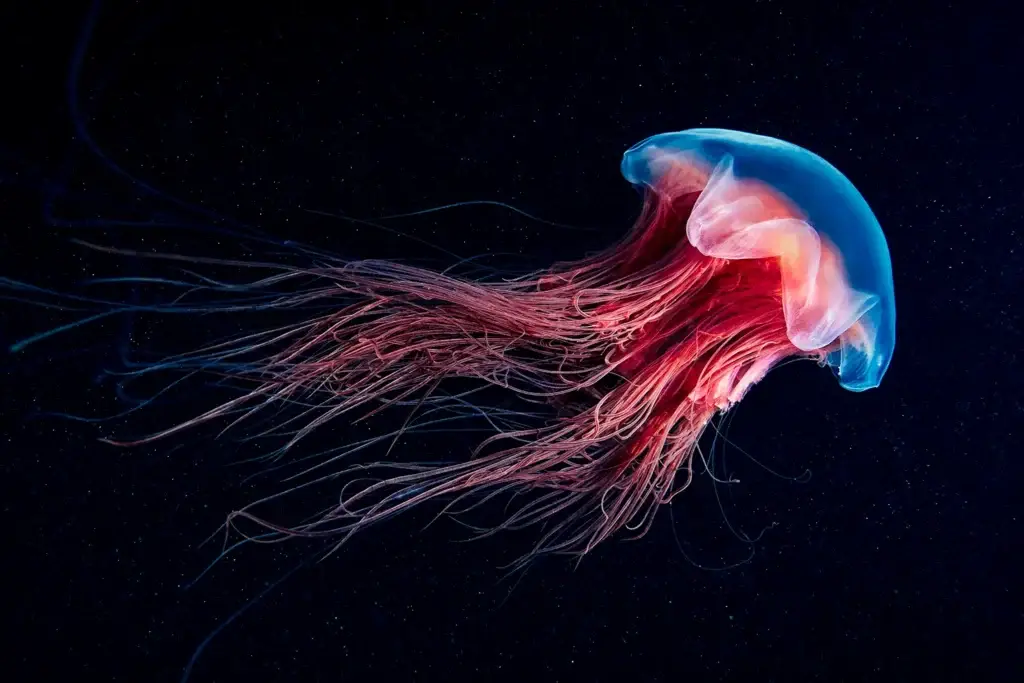
Krill
Krill, small crustaceans populating global oceans, hold a pivotal position in marine ecosystems. These organisms exhibit specific feeding and behavioral patterns that influence their interactions within the marine food web. Here’s an in-depth look at krill:
- Distribution: Krill are ubiquitously found in oceans worldwide. Their widespread distribution underscores their ecological significance and adaptability to various marine habitats.
- Diet: Primarily, krill feed on phytoplankton, the microscopic plants of the ocean, and other zooplankton species. This diet positions them as primary consumers in marine food chains, bridging the gap between primary producers and higher trophic levels.
- Ecological Role: Serving as a fundamental food source for larger marine animals, krill are integral to the sustenance of many marine species. Whales, seals, and various fish species rely heavily on krill for nourishment. Their role ensures the transfer of energy from the lower to the higher trophic levels in marine ecosystems.
- Behavioral Patterns: Exhibiting diel vertical migration, krill ascend to the ocean’s surface during nighttime and descend to deeper waters in the daytime. This behavior is believed to be a survival strategy, reducing their vulnerability to predators during daylight hours.
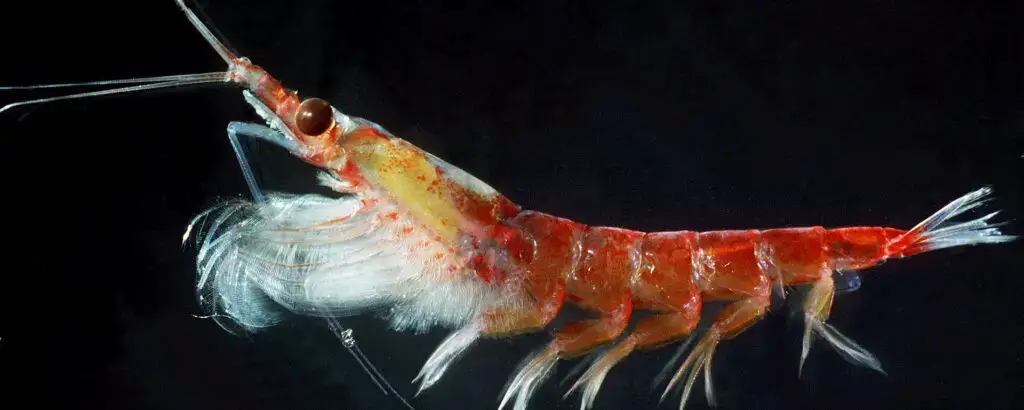
Conger Eel
Conger eels, sizable marine creatures, are notable inhabitants of the coastal waters of Europe and North America. Here’s a detailed examination of the Conger eel:
- Distribution: These eels predominantly inhabit the coastal regions of Europe and North America. Their presence in these areas highlights their adaptability to varied marine conditions across continents.
- Habitat Preference: Conger eels exhibit a preference for the ocean floor, often residing close to the sediment. This benthic lifestyle allows them to camouflage and interact closely with the seabed environment.
- Dietary Habits: As carnivorous organisms, Conger eels have a diet that primarily consists of crustaceans and small fish. Their predatory nature ensures they play a significant role in the marine food web, controlling the population of their prey and providing sustenance for larger predators.
- Ecological Role: Beyond their dietary habits, Conger eels contribute to the biodiversity of their habitats, influencing the ecological dynamics of coastal marine ecosystems.
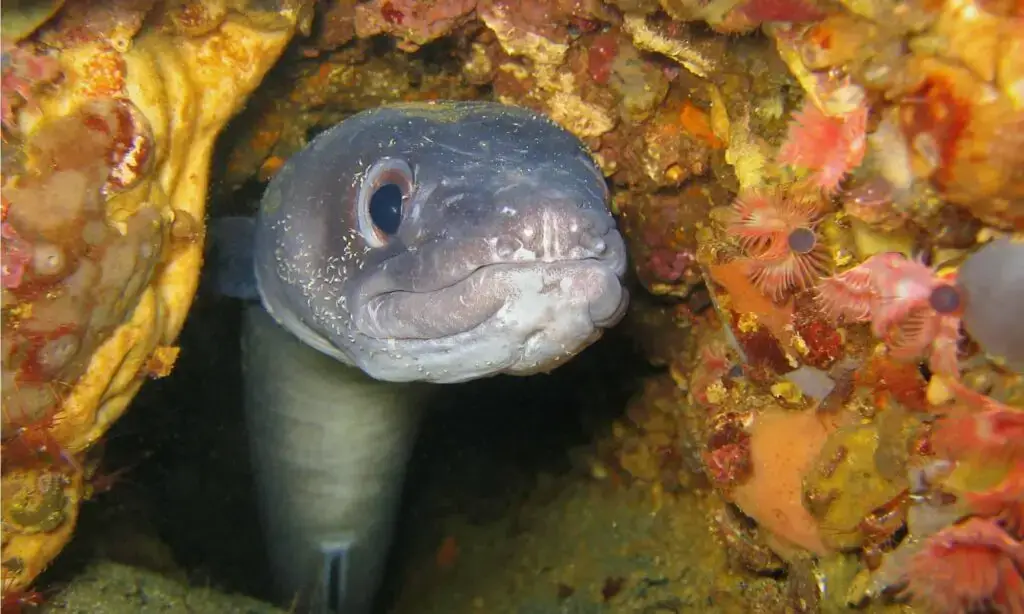
Segmented worm
Segmented worms, also known as annelids, are a distinct group of invertebrates characterized by their body’s division into multiple segments. Here’s an in-depth look at these organisms:
- Examples: The annelid group encompasses various species, including leeches and other ringed worms. These creatures showcase the characteristic segmented appearance that defines this group.
- Habitat Distribution: Predominantly, marine species of segmented worms inhabit coral reefs and tidal zones. These environments offer them the necessary conditions to thrive, from food sources to shelter.
- Ecological Role: One of the notable behaviors of segmented worms is their ability to burrow into sediment. This burrowing action serves a dual purpose: it provides the worm with shelter and, more importantly, oxygenates the sediment. The introduction of oxygen into the sediment is ecologically significant as it promotes the growth of aerobic bacterial species and supports other marine life that relies on oxygen-rich environments.
- Significance in Marine Ecosystems: Beyond their direct ecological contributions, segmented worms play a role in the broader marine food web. They serve as a food source for various predators and, in turn, help control the populations of the organisms they consume.
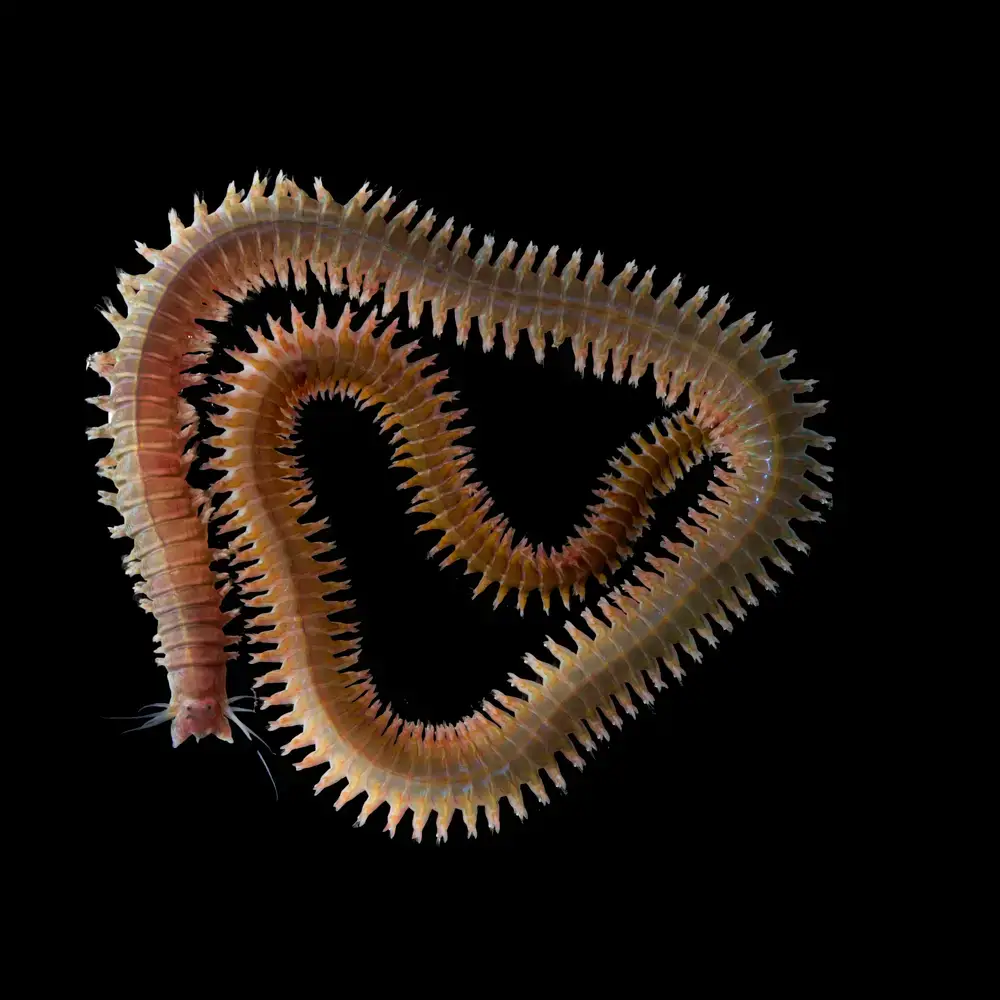
More Examples of Zooplankton
Here’s a detailed overview of some notable examples of zooplankton:
- Aquatic Sowbug or Water Louse: A small crustacean that thrives in freshwater habitats.
- Portuguese Man o’ War: Not a true jellyfish, but a siphonophore; a colony of specialized polyps and medusoids.
- Calanus Finmarchicus: A copepod species that plays a pivotal role in the North Atlantic marine food web.
- Ostreopsis Ovata: A type of dinoflagellate known for its potential to produce toxins.
- Blue Button (Porpita Porpita): A hydrozoan characterized by its bright blue, disc-shaped float.
- Acartia Tonsa: A widely distributed copepod species found in estuarine and coastal waters.
- Forams (Foraminiferans): Single-celled protists with shells, which play a role in marine sediment formation.
- Acartia Clausi: Another species of copepod, essential for marine food webs.
- Paracalanus Parvus: A small planktonic copepod found in marine environments.
- Common Pill-Bug: A terrestrial isopod that resembles a pill when it rolls up.
- Ligia Exotica: A type of isopod commonly found in coastal regions.
- Common Rough Woodlouse: A terrestrial isopod species.
- Giant Isopod: Deep-sea crustaceans known for their large size.
- Anchor Worms: Parasitic crustaceans that attach to fish.
- Air Fern: Not a true fern, but colonies of a small aquatic animal called Sertularia.
- Talitres Saltator: Also known as the sand hopper, a small amphipod crustacean.
- Common Salp: Gelatinous tunicates that drift in the open ocean.
- Pacific Sea Nettle: A species of jellyfish known for its long tentacles.
- Ligia Oceanica: A marine isopod species.
- By-the-Wind Sailor (Velella velella): A small free-floating hydrozoan.
- Flying Spaghetti Monster (Bathyphysa Conifer): A siphonophore found in deep-sea environments, named humorously after its unique appearance.
Role of Zooplankton in Food Chains
Zooplankton play a pivotal role in aquatic food chains, serving as a bridge between primary producers and higher trophic levels. Here’s an in-depth exploration of their significance:
- Central Component: Zooplankton are integral to the aquatic food chain. Their presence and abundance directly influence the health and balance of aquatic ecosystems.
- Intermediary Role: Acting as intermediary species, zooplankton facilitate the transfer of energy from primary producers, such as planktonic algae, to larger predators. This ensures the flow of energy and nutrients through the food chain.
- Ecological Interactions: The distribution and behavior of zooplankton can provide insights into the broader ecological dynamics of aquatic environments. Their interactions with other planktonic organisms, especially phytoplankton, are crucial for understanding various ecological processes and models.
- Predation and Control: Larger invertebrates and fish prey on zooplankton. This predation not only transfers energy up the food chain but also helps regulate zooplankton populations, ensuring a balance in their numbers.
- Grazing and Population Control: Zooplankton are essential grazers of algae and bacteria. By consuming these primary producers, they help control their populations, preventing overgrowth and potential harmful algal blooms.
- Nutrient Recycling: Beyond their role as consumers, zooplankton contribute to nutrient cycling in aquatic ecosystems. They excrete nitrogen and phosphorus, vital nutrients that phytoplankton require for growth. This recycling ensures that primary producers have a consistent supply of essential nutrients, promoting a balanced and productive ecosystem.
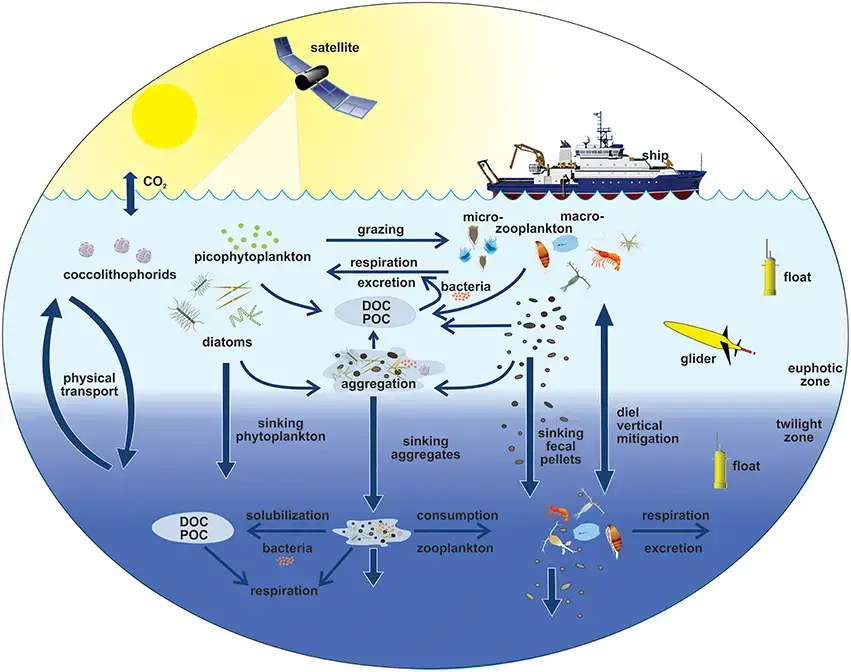
In essence, zooplankton are more than just passive drifters in aquatic environments. They actively shape and are shaped by the ecosystems they inhabit, playing a central role in maintaining the health and balance of aquatic food chains.
Role of Zooplankton in Biogeochemistry
Zooplankton play a pivotal role in marine biogeochemistry, influencing the cycling and distribution of carbon and other essential nutrients in the ocean. Here’s a detailed examination of their contributions:
- Biogeochemical Recyclers: Zooplankton act as vital recyclers in marine ecosystems, processing and redistributing carbon and other nutrients. Their activities directly influence major biogeochemical cycles, ensuring the continuity of essential processes in the marine environment.
- Influence on the Biological Pump: The biological pump is a process by which carbon is transported from the ocean’s surface to its depths. Zooplankton contribute to this by consuming carbon-rich phytoplankton at the surface and releasing it as waste or through respiration at deeper levels, facilitating carbon sequestration.
- Significance in Oligotrophic Environments: In nutrient-poor, oligotrophic open ocean regions, the role of zooplankton becomes even more crucial. Their recycling activities ensure the availability of essential nutrients, supporting primary production in these otherwise nutrient-limited areas.
- Regulation of Dissolved Organic Matter (DOM): Through various processes such as sloppy feeding, excretion, egestion, and the leaching of fecal pellets, zooplankton release DOM. This DOM is vital for the microbial loop, a process where microbes break down DOM, ensuring its recycling back into the marine food web.
- Complex Carbon Delivery: The efficiency with which zooplankton transfer and sequester carbon to the deep ocean is influenced by multiple factors. These include the size of their prey, their own respiration rates, and their absorption efficiency. Each of these factors can alter the amount and form of carbon reaching deeper ocean layers.
In summary, zooplankton are not merely passive participants in marine ecosystems. They actively shape biogeochemical processes, ensuring the efficient cycling and redistribution of vital nutrients, particularly carbon. Their activities are central to maintaining the health and balance of marine biogeochemical cycles.
Role of Zooplankton in Carbon Export
Zooplankton play a pivotal role in the marine carbon cycle, particularly in the process of carbon export. Their activities significantly influence the efficiency and dynamics of the ocean’s biological pump. Here’s an in-depth look at their contributions:
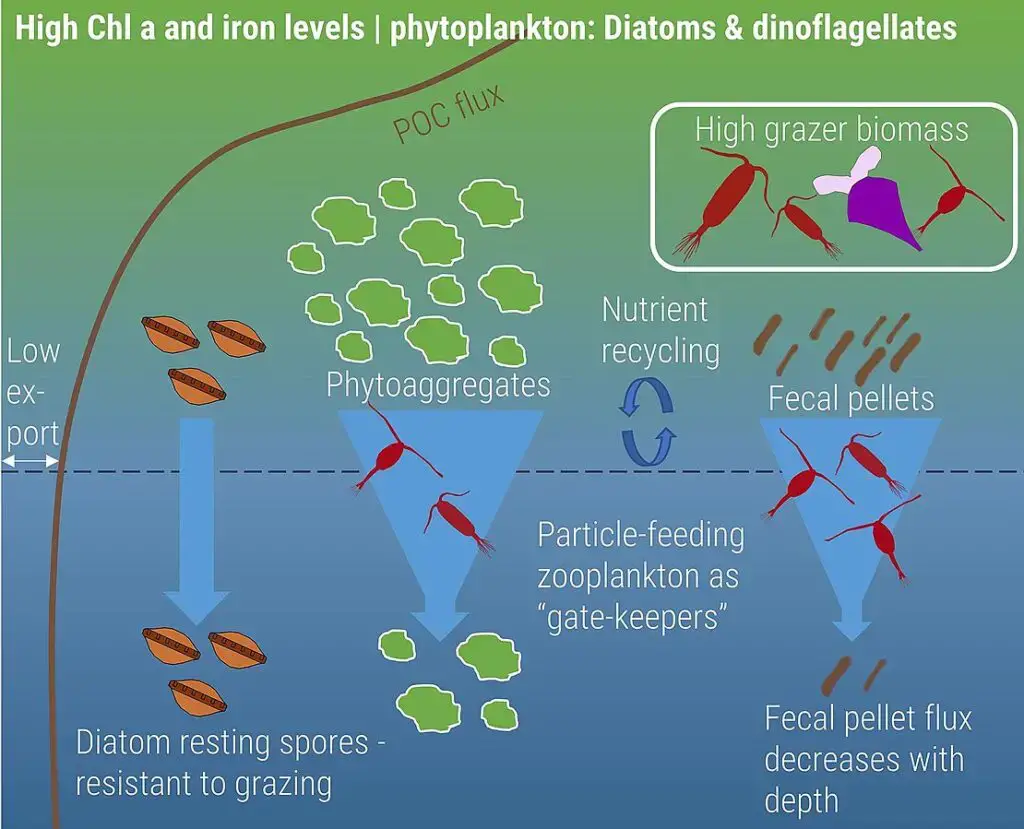
- Biological Pump and Carbon Export: The ocean’s biological pump is a mechanism that transfers carbon from the surface to the deeper layers of the ocean. Zooplankton are central to this process, facilitating carbon export through various means.
- Fecal Pellets: One of the primary mechanisms by which zooplankton contribute to carbon export is through the production of fecal pellets. These pellets, rich in carbon, sink to the ocean floor, sequestering carbon away from the atmosphere. The significance of these pellets in carbon export is such that their contribution is influenced more by the size of the copepod producing them than by the overall abundance of copepods.
- Temporal Variability: The efficiency of carbon export via fecal pellets is not constant. During zooplankton bloom events, there is a surge in the production of fecal pellets, leading to an increased rate of carbon export. This highlights the dynamic nature of the role zooplankton play in the carbon cycle, with their contribution varying based on ecological events and conditions.
- Bacterial Reworking: As fecal pellets descend through the water column, they are acted upon by bacteria. These bacteria rework the pellets, potentially altering their carbon composition. This bacterial interaction can influence the amount and form of carbon that eventually reaches the ocean floor.
- Other Export Mechanisms: Beyond fecal pellets, zooplankton contribute to carbon export through other means. The production of mucous feeding webs, molts, and even the sinking of dead zooplankton carcasses all contribute to the downward flux of carbon.
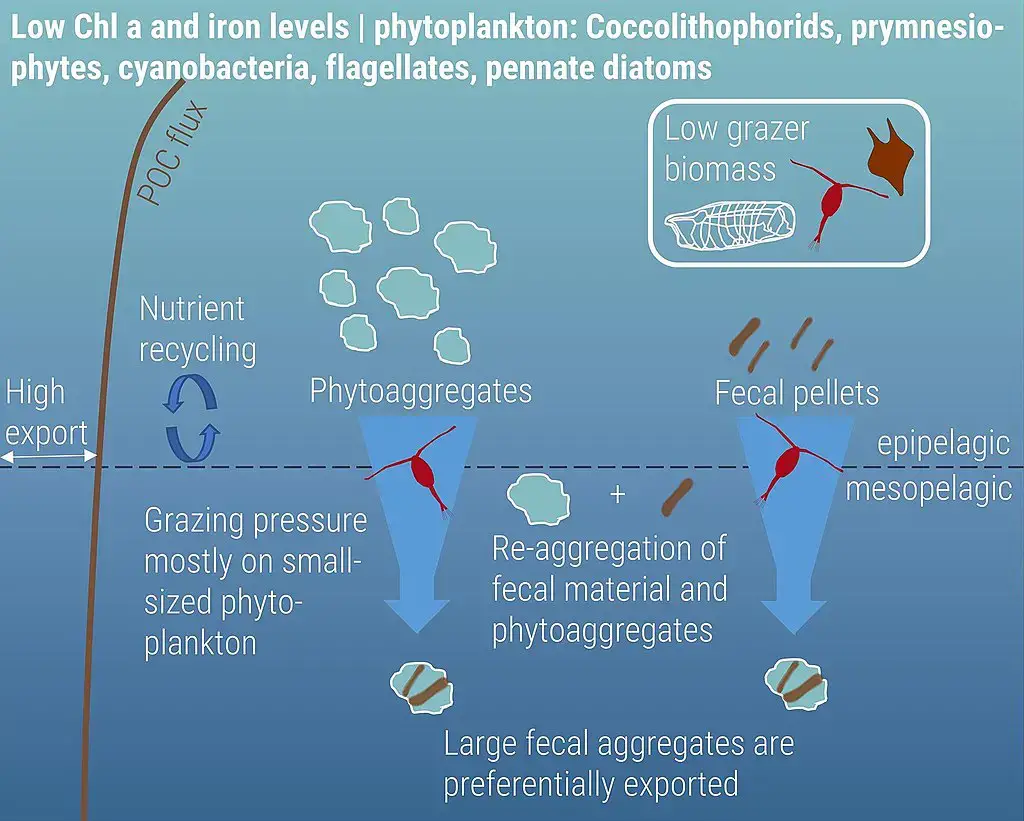
Threats of Zooplankton
Zooplankton, the microscopic organisms drifting in oceans, seas, and freshwater bodies, play a pivotal role in aquatic ecosystems. However, they face a myriad of threats that could jeopardize their existence and, by extension, the health of aquatic ecosystems. Here’s a comprehensive look at the challenges zooplankton confront:
- Climate Change:
- Temperature Shifts: Climate change, characterized by rising ocean temperatures, is pushing some zooplankton species to migrate to cooler waters. This movement disrupts the established food chains, potentially leaving their predators without a food source or forcing these predators to migrate as well.
- Warm-Water Plankton Proliferation: While some plankton species benefit from warmer waters, leading to an increase in their populations, this growth is not necessarily beneficial for the ecosystem. An overabundance of certain plankton types can reduce ecosystem diversity, which is vital for resilience and health.
- Nutrient Overload:
- Eutrophication: Excessive nutrient inputs, especially nitrogen and phosphorus from terrestrial agricultural activities, can lead to eutrophication. This process results in the explosive growth of certain phytoplankton species, potentially leading to harmful algal blooms.
- Ecological Imbalance: While some phytoplankton species thrive in nutrient-rich conditions, the disproportionate growth of these species can upset the balance of the ecosystem. Over time, these blooms can deplete oxygen levels in the water, harming other marine life.
- Plastic Pollution:
- Microplastic Ingestion: The proliferation of plastic pollution in marine environments poses a direct threat to zooplankton. Recent studies have shown that certain zooplankton species are ingesting microplastics, tiny plastic fragments that resemble their natural food sources.
- Toxicity: The ingestion of plastics introduces a range of harmful chemicals into the zooplankton’s system. These chemicals can be inherent to the plastic, such as Bisphenol A (BPA), or they can be environmental toxins that have adhered to the plastic, like DDT. When predators consume zooplankton laden with these toxins, the chemicals can bioaccumulate, posing health risks to larger marine animals and even humans.
- Ocean Acidification:
- Carbon Dioxide Absorption: As atmospheric carbon dioxide levels rise due to human activities, the oceans absorb a significant portion of this CO2. This absorption leads to a decrease in the pH of seawater, making it more acidic.
- Impact on Calcifying Organisms: Ocean acidification affects zooplankton species that rely on calcium carbonate for their shells and skeletons, such as certain types of foraminifera. As the water becomes more acidic, it becomes harder for these organisms to build and maintain their calcium carbonate structures.
- Overfishing:
- Food Web Disruption: Overfishing of certain fish species can disrupt the natural balance of marine food webs. When predators of zooplankton are removed in large numbers, it can lead to an overabundance of zooplankton, which can then overgraze on phytoplankton, disrupting the primary productivity of marine ecosystems.
- Bycatch: Many zooplankton species, especially larger ones, can be unintentionally caught as bycatch during commercial fishing operations, leading to declines in their populations.
- Invasive Species:
- Competition: The introduction of non-native species can pose a threat to native zooplankton populations. These invasive species can outcompete native zooplankton for food resources, leading to declines in native populations.
- Predation: Some invasive species might prey on native zooplankton, further reducing their numbers.
- Pollution and Contaminants:
- Chemical Pollutants: Apart from plastics, other pollutants like heavy metals, pesticides, and industrial waste can accumulate in zooplankton, affecting their health and the health of their predators.
- Oil Spills: Large-scale oil spills can have a devastating impact on zooplankton populations. The oil can suffocate, poison, or physically trap these tiny organisms.
- Habitat Destruction:
- Coastal Development: Activities such as dredging, land reclamation, and the construction of ports can destroy the habitats where many zooplankton species thrive.
- Marine Traffic: Increased marine traffic can lead to noise pollution, which may disrupt the natural behaviors of zooplankton, affecting their feeding and reproductive patterns.
- Ultraviolet (UV) Radiation:
- Ozone Depletion: The depletion of the ozone layer due to certain human-made chemicals allows more UV radiation to penetrate the Earth’s atmosphere. Increased UV exposure can harm zooplankton, especially those in the upper layers of the water column.
What are the Benefits of Zooplankton?
Zooplankton, as microscopic organisms inhabiting aquatic ecosystems, serve pivotal roles that extend beyond their immediate environment. Their significance can be elucidated through the following benefits:
- Central Role in Aquatic Food Webs: Zooplankton are integral components of aquatic food chains. Positioned between primary producers like phytoplankton and higher trophic levels like fish, they facilitate the transfer of energy and nutrients through the ecosystem.
- Water Quality Enhancement: The presence and activity of zooplankton can influence water quality. By feeding on algae, they can regulate algal populations, thereby preventing excessive algal growth that could otherwise lead to detrimental algal blooms.
- Biomonitoring Indicators: Due to their sensitivity to environmental alterations, zooplankton species are often incorporated into biomonitoring programs. Their population dynamics can provide insights into the health and stability of aquatic ecosystems, making them valuable indicators of environmental change.
- Augmentation of Fish Production: Certain zooplankton species, exemplified by Mysis, have been deliberately introduced into aquatic habitats with the aim of enhancing fish productivity. Their presence can bolster the food supply for fish, promoting growth and abundance.
- Biomanipulation for Algal Control: Zooplankton grazing can be harnessed as a tool to manage and mitigate algal blooms, a phenomenon known as biomanipulation. By manipulating the populations of zooplankton predators, either through direct removal or the introduction of apex predators, zooplankton numbers can be bolstered. This, in turn, intensifies their grazing on algae, curtailing excessive algal growth and averting the adverse effects of eutrophication.
Difference Between Zooplankton and Phytoplankton
The aquatic ecosystems are teeming with diverse microscopic organisms that play pivotal roles in the sustenance and balance of marine and freshwater habitats. Among these, zooplankton and phytoplankton are two primary categories that, despite their similarities in size and habitat, exhibit distinct characteristics. Herein, we delineate the differences between these two groups:
1. Nature and Classification:
- Phytoplankton: Resembling plants in their functionality, phytoplankton are primarily autotrophic, harnessing energy from sunlight through photosynthesis.
- Zooplankton: These are more animal-like in nature, relying on other organisms for sustenance.
2. Habitat:
- Phytoplankton: Ubiquitous in both freshwater and marine environments.
- Zooplankton: Predominantly found in water bodies, spanning from freshwater to marine habitats.
3. Appearance:
- Phytoplankton: When amassed, they often manifest as cloudy brown patches in water.
- Zooplankton: Exhibiting a diverse array of colors and shapes, most zooplankton are translucent.
4. Oxygen Dynamics:
- Phytoplankton: Being photosynthetic, they release significant amounts of oxygen into the water.
- Zooplankton: Contrarily, zooplankton are oxygen consumers.
5. Nutritional Mode:
- Phytoplankton: They are autotrophs, synthesizing their own food through photosynthesis or chemosynthesis.
- Zooplankton: Heterotrophic in nature, they feed on other organisms, including phytoplankton and even other zooplankton.
6. Position in the Food Web:
- Phytoplankton: They form the base of the aquatic food web, acting as primary producers.
- Zooplankton: Depending on the species, they can be primary consumers (feeding directly on phytoplankton) or secondary consumers.
7. Exemplary Species:
- Phytoplankton: Some representative species include Cyanobacteria, Blue-green algae, diatoms, and dinoflagellates.
- Zooplankton: This group encompasses a wide range of species such as krill, meroplankton, protozoa, and holoplankton.
| Criteria | Phytoplankton | Zooplankton |
|---|---|---|
| Nature and Classification | Resemble plants; primarily autotrophic. | Resemble animals; rely on other organisms for sustenance. |
| Habitat | Found in both freshwater and marine environments. | Predominantly found in water bodies, from freshwater to marine habitats. |
| Appearance | When amassed, form cloudy brown patches. | Translucent with diverse colors and shapes. |
| Oxygen Dynamics | Release significant amounts of oxygen (photosynthesis). | Consume oxygen. |
| Nutritional Mode | Autotrophs; synthesize food through photosynthesis or chemosynthesis. | Heterotrophs; feed on phytoplankton and other zooplankton. |
| Position in the Food Web | Primary producers. | Primary or secondary consumers. |
| Exemplary Species | Cyanobacteria, Blue-green algae, diatoms, dinoflagellates. | Krill, meroplankton, protozoa, holoplankton. |
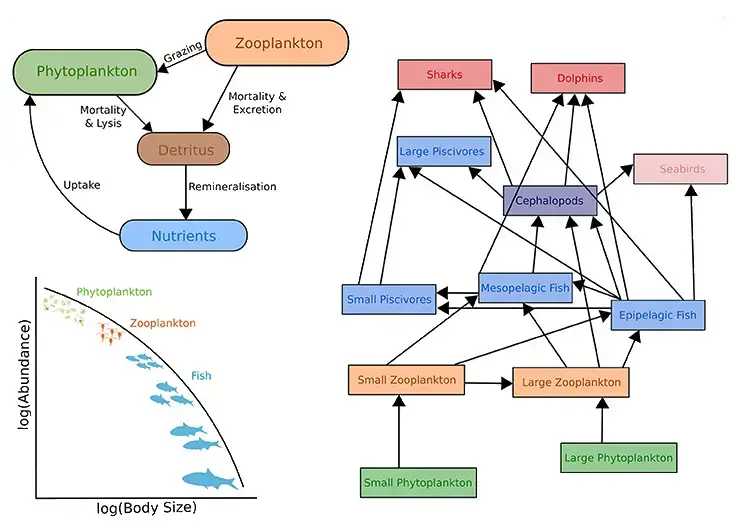
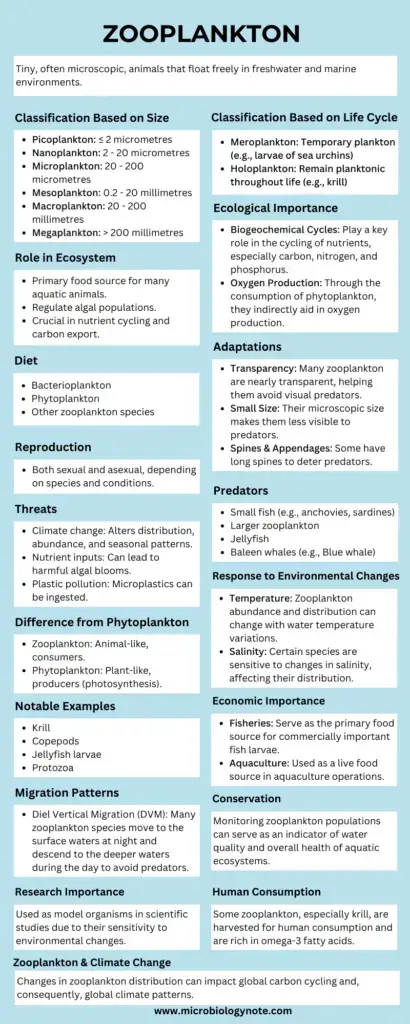
Quiz
Which of the following is NOT a type of zooplankton?
a) Copepod
b) Krill
c) Diatom
d) Radiolarian
What do zooplankton primarily feed on?
a) Large fish
b) Seaweed
c) Phytoplankton
d) Coral
Which zooplankton is known for its bioluminescence?
a) Dinoflagellates
b) Copepods
c) Foraminiferans
d) Molluscs
Which of the following is a primary threat to zooplankton populations?
a) Climate change
b) Overfishing
c) Coral bleaching
d) Seagrass decline
Which zooplankton is a primary food source for many whales?
a) Radiolarians
b) Krill
c) Cnidarians
d) Foraminiferans
Which of the following zooplankton remains planktonic throughout its life?
a) Meroplankton
b) Holoplankton
c) Macroplankton
d) Megaplankton
Which zooplankton is known for its silica-based skeleton?
a) Copepods
b) Krill
c) Radiolarians
d) Cnidarians
Which zooplankton is a type of amoeboid protist with an external shell?
a) Dinoflagellates
b) Foraminiferans
c) Cnidarians
d) Copepods
Which of the following is NOT a role of zooplankton in marine ecosystems?
a) Oxygen production
b) Carbon recycling
c) Primary production
d) Nutrient cycling
Which zooplankton is known to consume plastic in polluted waters?
a) Krill
b) Copepods
c) Radiolarians
d) Cnidarians
FAQ
What are zooplankton?
Zooplankton are tiny, often microscopic, animals that float freely in freshwater and marine environments.
How do zooplankton fit into the aquatic food chain?
Zooplankton play a crucial role in the aquatic food chain, serving as a primary food source for many larger aquatic animals, including fish.
What’s the difference between zooplankton and phytoplankton?
While both are planktonic in nature, zooplankton are animal-like and consume other organisms, whereas phytoplankton are plant-like and produce their own food through photosynthesis.
How do zooplankton reproduce?
Zooplankton reproduce both sexually and asexually, depending on the species and environmental conditions.
Why are zooplankton important for aquatic ecosystems?
Zooplankton help regulate algal populations, provide a food source for larger animals, and play a role in nutrient cycling and carbon export.
Do zooplankton have any predators?
Yes, zooplankton are preyed upon by various aquatic animals, including small fish, larger zooplankton species, and even some species of whales.
How are zooplankton affected by climate change?
Climate change can alter the distribution, abundance, and seasonal patterns of zooplankton, which can have cascading effects on the larger aquatic ecosystem.
What are the different types of zooplankton?
Zooplankton can be classified into various groups based on size (like picoplankton, nanoplankton) or life cycle (like meroplankton, holoplankton).
How do researchers study zooplankton?
Researchers use specialized nets to collect zooplankton samples from water bodies. These samples are then analyzed under microscopes for identification and counting.
Can zooplankton be seen with the naked eye?
While many zooplankton species are microscopic, some, like certain jellyfish and krill, are large enough to be seen without magnification.
References
- LALLI, C. M., & PARSONS, T. R. (1997). ZOOPLANKTON. Biological Oceanography: An Introduction, 74–111. doi:10.1016/b978-075063384-0/50060-8
- Dos Santos Severiano et al. (2018). Effects of increased zooplankton biomass on phytoplankton and cyanotoxins: A tropical mesocosm study. Harmful Algae. 71:10-18.
- Weisse, T. (2017). Functional diversity of aquatic ciliates. Eur J Protistol. 61(Pt B):331-358.
- Text Highlighting: Select any text in the post content to highlight it
- Text Annotation: Select text and add comments with annotations
- Comment Management: Edit or delete your own comments
- Highlight Management: Remove your own highlights
How to use: Simply select any text in the post content above, and you'll see annotation options. Login here or create an account to get started.